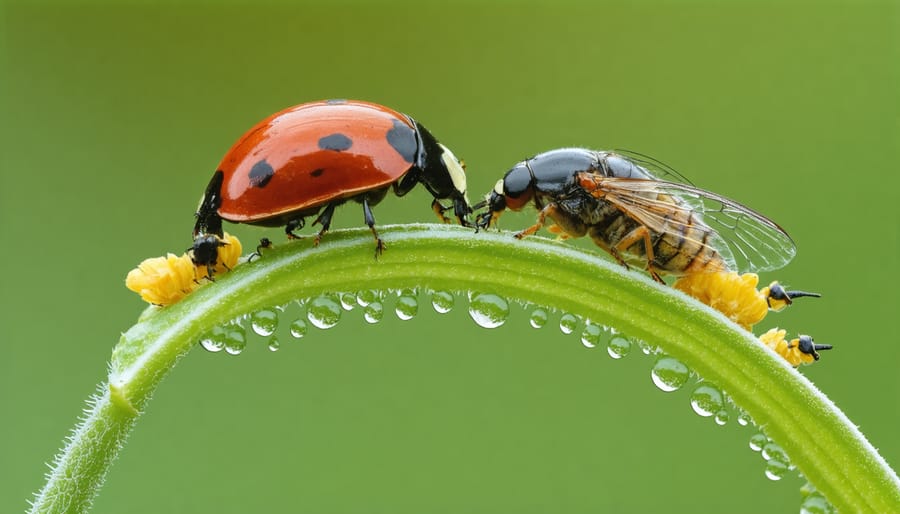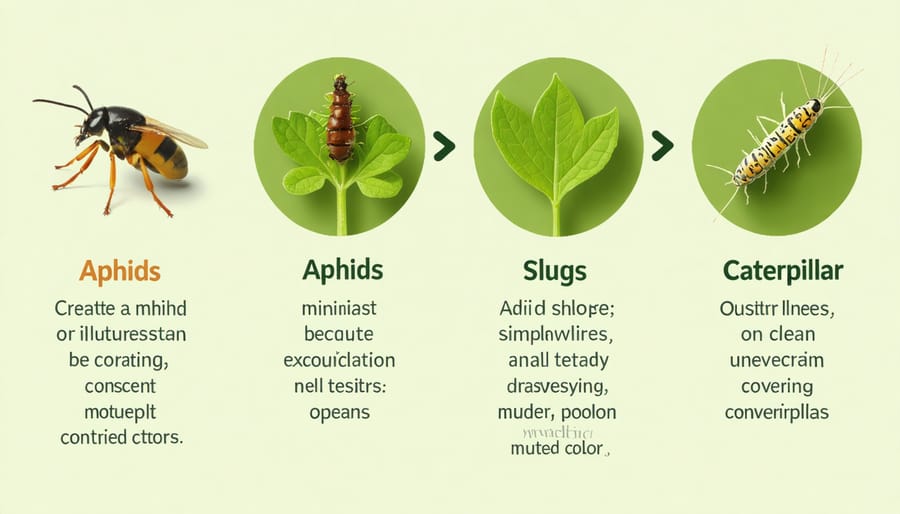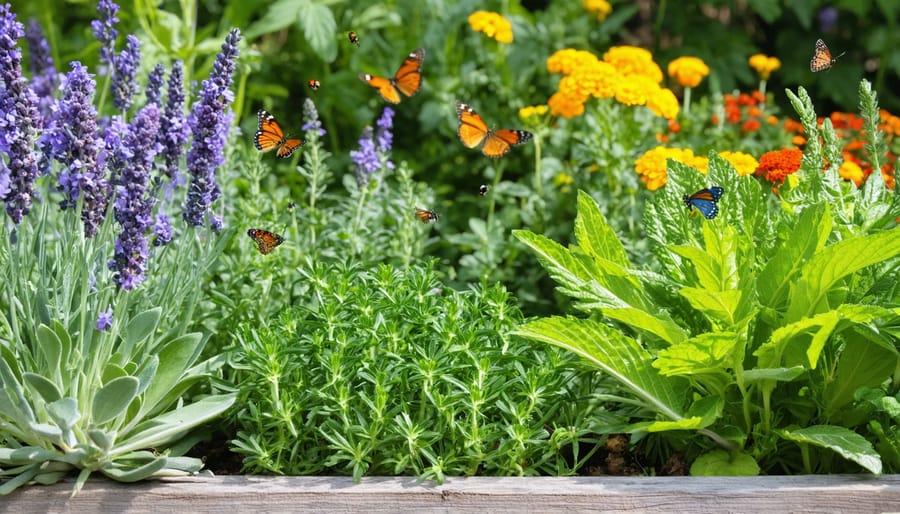Transform your garden into a self-regulating ecosystem by integrating beneficial insects, companion planting, and natural pest deterrents. Plant aromatic herbs like lavender, rosemary, and marigolds strategically throughout your growing spaces to naturally repel unwanted insects while attracting pollinators. Create diverse habitat zones that follow the principles of permaculture, encouraging predatory insects like ladybugs and praying mantises to establish permanent populations. Maintain healthy soil biology through regular applications of compost tea and organic mulch, strengthening plants’ natural defense mechanisms against pests. This holistic approach eliminates the need for harmful pesticides while fostering a thriving, balanced garden ecosystem that manages pest problems naturally.
Rather than fighting against nature, sustainable pest management works with existing ecological systems to create lasting solutions. By understanding the intricate relationships between plants, insects, and soil life, gardeners can build resilient landscapes that require minimal intervention while producing abundant harvests. These time-tested methods not only protect your garden but also contribute to broader environmental health and biodiversity.
The Three Pillars of Permaculture Pest Management
Prevention Through Design
Creating a garden that naturally deters pests starts with thoughtful design and plant selection. Think of your garden as a living ecosystem where every element plays a role in maintaining balance. By incorporating companion planting principles, you can create natural barriers and beneficial relationships between plants that help ward off unwanted visitors.
Start by planning your garden layout with diversity in mind. Mix flowers, herbs, and vegetables instead of planting in single-crop rows. For instance, marigolds naturally repel many garden pests while attracting beneficial insects. Plant aromatic herbs like basil, mint, and rosemary throughout your vegetable beds – their strong scents confuse and deter many common pests.
Incorporate vertical elements and different plant heights to create multiple layers of growth. This approach, known as vertical gardening, not only maximizes space but also provides habitat for beneficial insects and natural predators that help control pest populations.
Consider creating wildlife corridors and refuge areas within your garden. Small brush piles, water features, and native flowering plants attract birds, beneficial insects, and other natural pest controllers. Leave some areas slightly wild – these become natural hunting grounds for pest-eating creatures like birds and predatory insects.
Remember to rotate your crops annually to prevent pest populations from becoming established in specific areas. This simple practice breaks pest life cycles and helps maintain soil health, creating stronger, more resilient plants that naturally resist pest damage.

Observation and Monitoring
Regular observation is your garden’s secret weapon against pest problems. Take 15 minutes each week to walk through your garden, noting any changes in plant health or unusual insect activity. Keep a simple garden journal to track patterns – you’ll be surprised how much you can learn about your garden’s ecosystem!
Learn to identify the good guys in your garden. Ladybugs, praying mantises, and parasitic wasps are your allies, feeding on common pests like aphids and caterpillars. Ground beetles, often spotted scurrying away when you lift a garden stone, help control slugs and other ground-dwelling pests.
Watch for early warning signs of pest problems. Yellow or spotted leaves, chewed plant edges, or sticky residue on leaves can indicate pest presence. The key is catching these signs early, before the problem becomes severe. Morning is the best time for observation, as many insects are most active then.
Consider installing insect hotels or leaving small brush piles to attract beneficial insects. Pay attention to seasonal patterns – many pests emerge at specific times of the year or during certain weather conditions. Understanding these cycles helps you prepare and respond more effectively.
Remember, seeing a few insects on your plants isn’t always cause for alarm. A healthy garden ecosystem maintains a natural balance between pests and beneficial insects. Your goal is to monitor and maintain this balance, not eliminate all insects.
Natural Intervention Methods
When prevention isn’t enough, there are numerous natural solutions that can help manage pest problems while maintaining garden harmony. Companion planting with aromatic herbs like basil, marigolds, and lavender naturally repels many unwanted insects while attracting beneficial ones. These plants not only protect your garden but also add beauty and variety to your space.
Introducing beneficial insects is another effective approach. Ladybugs, praying mantises, and parasitic wasps act as natural predators, keeping pest populations in check. You can attract these helpful allies by planting native flowers and providing shallow water sources.
For more immediate intervention, natural sprays can be remarkably effective. A simple solution of neem oil and water helps control various pests while being safe for beneficial insects. Garlic and hot pepper sprays are also excellent deterrents that you can easily make at home. Many gardeners swear by a mixture of liquid soap and water for soft-bodied insects like aphids.
Physical barriers offer another layer of protection. Row covers, sticky traps, and copper tape can prevent pests from reaching your plants. Diatomaceous earth, sprinkled around vulnerable plants, creates a natural barrier against crawling insects.
Remember to apply these methods selectively and observe their effects. The goal isn’t to eliminate all insects but to maintain a healthy balance in your garden ecosystem.
Building Your Garden’s Natural Defense System
Attracting Beneficial Insects
Creating a garden that welcomes beneficial insects is like extending an invitation to nature’s pest control team. By attracting beneficial pollinators and predatory insects, you’ll establish a natural balance that helps keep pest populations in check.
Start by planting umbrella-shaped flowers like dill, fennel, and Queen Anne’s lace, which are particularly attractive to parasitic wasps and ladybugs. These tiny warriors feed on aphids, caterpillars, and other common garden pests. Herbs such as oregano, thyme, and mint not only enhance your cooking but also draw in helpful insects with their aromatic blooms.
Consider creating diverse plant heights and structures in your garden. Low-growing herbs, mid-height flowering plants, and taller perennials provide different habitat layers that beneficial insects need. Leaving a small patch of bare soil allows ground-dwelling insects like beetles to make their homes.
Adding a shallow water source, like a dish filled with pebbles and water, provides drinking spots for beneficial insects. Native flowering plants are particularly effective, as they’ve evolved alongside local insect species. Try yarrow, echinacea, and goldenrod for long-lasting blooms that support beneficial insects throughout the growing season.
Remember to avoid using chemical pesticides, as these can harm the very insects you’re trying to attract. With patience, your garden will develop its own pest management system, naturally maintaining a healthy ecological balance.

Creating Habitat Diversity
Creating diverse habitats in your garden is one of the most effective ways to create a balanced ecosystem that naturally controls pest populations. Think of your garden as a miniature world where different creatures need various places to live, feed, and thrive.
Start by incorporating different plant heights and structures. Tall trees and shrubs provide shelter for birds that eat insects, while lower-growing herbs and ground covers offer hiding spots for beneficial insects like ground beetles. Adding a mix of flowering plants that bloom at different times ensures year-round food sources for pollinators and predatory insects.
Water features, even small ones like a shallow dish with pebbles, attract helpful creatures like frogs and dragonflies that feast on garden pests. Leave some bare soil patches for ground-nesting bees, and stack old logs or branches in quiet corners to create homes for beneficial insects and small reptiles.
Consider creating “insect hotels” by bundling hollow stems or drilling holes in blocks of wood. These simple structures provide nesting sites for solitary bees and parasitic wasps that help control pest populations. Remember to include some native plants in your design – they’re perfectly adapted to support local beneficial insects and have evolved alongside them over thousands of years.

Sustainable Solutions for Common Garden Pests
Dealing with Aphids Naturally
Aphids may be tiny, but these persistent garden pests can quickly become a significant problem for any gardener. Fortunately, nature provides several effective solutions for managing these sap-sucking insects without resorting to harmful chemicals. One of the most reliable methods is encouraging beneficial insects like ladybugs and lacewings, which naturally prey on aphids. You can attract these helpful garden allies by planting flowers such as dill, fennel, and yarrow.
A quick blast of water from your garden hose can knock aphids off your plants, disrupting their colonies and reducing their numbers. For stubborn infestations, try mixing a natural soap solution using one tablespoon of mild liquid soap per quart of water. Spray this mixture directly on affected plants in the early morning or evening to avoid leaf burn.
Companion planting also plays a crucial role in aphid management. Strong-smelling herbs like basil, garlic, and nasturtiums can help repel aphids naturally. Creating diversity in your garden not only deters pests but also promotes a healthier ecosystem overall. Remember to regularly inspect your plants and act quickly when you spot the first signs of aphid activity – prevention is always easier than cure.
Slug and Snail Management
Slugs and snails can be challenging garden visitors, but there are numerous eco-friendly ways to manage them without resorting to harmful chemicals. One of the most effective methods is creating physical barriers using copper tape around raised beds or containers – slugs and snails receive a mild electrical shock when they contact copper, encouraging them to move elsewhere.
Consider inviting natural predators into your garden by creating habitats for birds, frogs, and beneficial insects. These garden allies will help keep gastropod populations in check naturally. You can also set up simple traps using shallow containers filled with beer or a mixture of yeast and water, which attracts slugs and snails away from your plants.
Maintaining good garden hygiene is crucial – remove hiding spots like loose boards, bricks, or dense ground cover where these pests shelter during the day. Timing your watering for early morning allows soil to dry before evening when slugs and snails are most active. For additional protection, spread sharp materials like crushed eggshells or diatomaceous earth around vulnerable plants – these create uncomfortable barriers for soft-bodied pests to cross.
Caterpillar Control
Managing caterpillars in your garden requires a delicate balance between protecting your plants and preserving beneficial species. Start by identifying which caterpillars are present – not all are harmful, and some transform into beautiful pollinators like butterflies and moths that benefit your garden ecosystem.
For unwanted caterpillars, handpicking remains one of the most effective and environmentally friendly control methods. Simply inspect your plants regularly and remove any problematic caterpillars you find. Drop them into soapy water or relocate them far from your garden.
Encourage natural predators like birds, parasitic wasps, and ground beetles by creating diverse habitats in your garden. Installing bird feeders and native flowering plants can help maintain a healthy balance of beneficial insects that naturally control caterpillar populations.
If additional control is needed, consider using Bacillus thuringiensis (Bt), a naturally occurring soil bacterium that specifically targets caterpillars while being safe for other insects, pets, and humans. Apply it sparingly and only when necessary, preferably in the evening when beneficial insects are less active.
Physical barriers like row covers can protect young plants during peak caterpillar seasons while still allowing sunlight and water to reach your crops.
Embracing sustainable pest management in your garden isn’t just good for the environment – it’s a rewarding journey that leads to a healthier, more balanced garden ecosystem. By incorporating companion planting, encouraging beneficial insects, and using natural deterrents, you’re creating a garden that works with nature rather than against it. Start small by implementing one or two techniques, such as planting marigolds near your vegetables or setting up an insect hotel. As you become more comfortable with these methods, gradually expand your sustainable practices. Remember, every small step toward natural pest control makes a difference. Your garden will thank you with stronger plants, better yields, and a thriving ecosystem that largely manages itself. The satisfaction of controlling pests without harmful chemicals while contributing to environmental conservation makes the effort truly worthwhile. Why not start your sustainable pest management journey today?




